What is The Evil Eye?
All About The Evil Eye
- History and Meaning of the Evil Eye
- Methods of Protection Against the Evil Eye
- Evil Eye Amulet and Talisman
- The Evil Eye in Modern Life
- Evil Eye Jewelry
- The Evil Eye - Just a Myth?
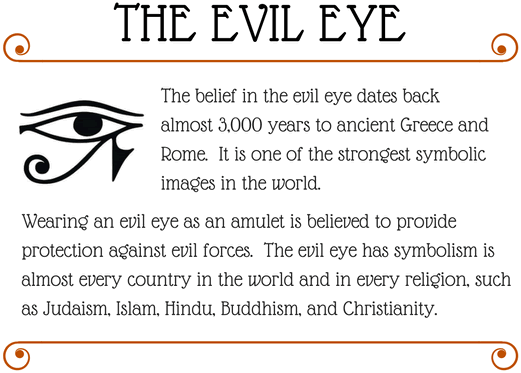

The evil eye. Chances are you have seen this famous symbol many times. You’ve probably even worn one and you’ve definitely seen someone wearing an evil eye amulet. You may have witnessed a person give the “evil eye” look (and you may have even given it yourself). But do you know the deep and meaningful history of the evil eye symbol, and do you know how popular and prevalent the evil eye is throughout a plethora of different cultures? Below is the need-to-know information on the symbol that is so popular, it is currently one of the most trendy pieces of jewelry.
History and Meaning of the Evil Eye
The symbol and superstition of the evil eye is one of the strongest symbolic images in the world. Yet, despite the differences in the cultures which hold the evil eye myth, it retains largely the same meaning no matter where the story is told. The evil eye is thought of as a look given to inflict harm, suffering, or some form of bad luck on those that it is cast upon. It is a look which clearly states that one intends for something bad to happen to the object of one’s focus, either out of jealousy or pure malice. The superstition of the evil eye holds that the malicious look is powerful enough to bring about actual disaster for the unfortunate person that is the receiver of the glare.
 The earliest known evidence for belief in the evil eye goes back to ancient Greece and Rome. It was believed that the evil eye was the largest threat to anyone who had been praised too much, or received admiration beyond what they truly deserved. The praised person would become so swollen with pride that he or she would bring about his or her own doom via the evil eye, which was believed to be able to cause physical and mental illness. In fact, any disease which did not have an immediate, obvious cause was thought to be caused by the evil eye. It was thought that the gods and goddesses were punishing those who had become too proud of their achievements, and destroyed them with the power of the evil eye to restore them to the level of mere mortals.
The earliest known evidence for belief in the evil eye goes back to ancient Greece and Rome. It was believed that the evil eye was the largest threat to anyone who had been praised too much, or received admiration beyond what they truly deserved. The praised person would become so swollen with pride that he or she would bring about his or her own doom via the evil eye, which was believed to be able to cause physical and mental illness. In fact, any disease which did not have an immediate, obvious cause was thought to be caused by the evil eye. It was thought that the gods and goddesses were punishing those who had become too proud of their achievements, and destroyed them with the power of the evil eye to restore them to the level of mere mortals.
A belief in the evil eye is widespread on every continent. The Middle East, Asia, Europe, and Central America all fear the evil eye. In Shahih Muslim Book 26, the prophet Muhammad warns about the dangers of the evil eye and says that one must take a bath in order to counteract the effects of the evil eye’s power.
Much as in Classic Greece and Ancient Rome, Islamic culture holds that excessive praise will bring about the ill effects of the evil eye. Thus, instead of praising an adorable child, one is supposed to say that “God has willed” the child’s good lucks, or risk endangering the youth. Ashkenazi Jews also believe that excessive praise causes a vulnerability to the evil eye, and will repeat a Yiddish phrase, "Keyn aynhoreh!" meaning “no evil eye” in order to protect against it.
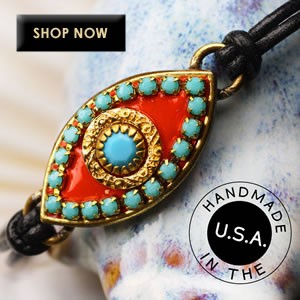 The evil eye is a powerful superstition in India. Hinduism preaches that the eye is the most powerful point at which the body can give off energy. Thus, a strong fear of an “evil” look from the eye makes sense; the evil eye holds enormous powers. The Hindus fear that even an “admirable” eye can bring about ill luck, resulting in the supply of milk from cows drying up (again, this idea dates back to the fear of undue praise, first warned against in Greece). In fact, the Hindus will offer the “admiring” glancer a bowl of milk to counteract the threat of the evil eye.
The evil eye is a powerful superstition in India. Hinduism preaches that the eye is the most powerful point at which the body can give off energy. Thus, a strong fear of an “evil” look from the eye makes sense; the evil eye holds enormous powers. The Hindus fear that even an “admirable” eye can bring about ill luck, resulting in the supply of milk from cows drying up (again, this idea dates back to the fear of undue praise, first warned against in Greece). In fact, the Hindus will offer the “admiring” glancer a bowl of milk to counteract the threat of the evil eye.
The Hindus believe that jealousy is at the root of the power of the evil eye, whether in the form of a malicious or admirable look. Interestingly, the Hindus teach that the times of change in life--as in during puberty, marriage, or childbirth--one is most vulnerable to the threat of the evil eye.
Hindus believe that even animals such as the snake are capable of giving one the evil eye. The Hindus believe that, even though men are capable of casting the evil eye, women are the most common sources of the glance. For this reason, in South India women will paint their eyelids black to protect themselves from the evil eye, and to prevent themselves from eyeing another with the look.
In South America, Brazil holds a superstition equivalent to the evil eye known as the “fat eye.” Compliments which are sincere are not feared to cause the evil eye to attack as in other countries, but insincere compliments are thought to put one at stake.
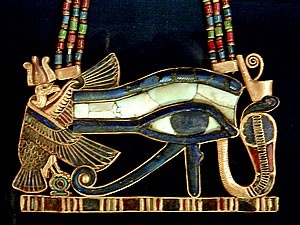 In Europe, the myth of the evil eye also originated with the idea that envious or malicious looks had the power to bring about bad luck. The largest source of the evil eye was believed to be witches. Yet those with eye colors which were rare were also seen as powerful possessors of the evil eye look. For instance, Germans feared those with red eyes. In Ireland, those with squinty eyes were feared to be evil eye sorcerers. In Italy, the unibrow was another sign that one would cast an evil eye.
In Europe, the myth of the evil eye also originated with the idea that envious or malicious looks had the power to bring about bad luck. The largest source of the evil eye was believed to be witches. Yet those with eye colors which were rare were also seen as powerful possessors of the evil eye look. For instance, Germans feared those with red eyes. In Ireland, those with squinty eyes were feared to be evil eye sorcerers. In Italy, the unibrow was another sign that one would cast an evil eye.
The fear of the evil eye did not carry over to America, except in the form of a metaphor. While the superstition is not intense enough to take precaution, the evil eye is seen as impolite, and a warning that the source of the evil eye has bad intentions.
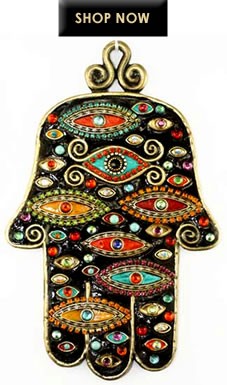
In different languages, the evil eye is known as:
- Hebrew Evil Eye – Ayin Ha’ra
- Turkish Evil Eye – Nazar Boncugu
- Italian Evil Eye – Mal Occhio
- Farsi – Bla Band
- Arabic – Ayin Harsha
- Scotland – Droch Shuil
- Spanish – Mal Ojo or El Oja
- France – Mauvais Oeil
- Germany – Böser Blick
- Romans – Oculus Malus
Methods of Protection against the Evil Eye
In addition to the use of evil eye amulets, the Greeks would carry incense or the cross as protection against the evil eye. New mothers would keep objects as protection under their pillows or on their heads, and these included red, black, or white strings, a nail, gunpowder, bread, salt, garlic, a ring, indigo blue, or a pair of silver buckles. Each of these objects held a meaning which made it a good defense against the evil eye. For instance, gunpowder symbolized an ability to fight back against the evil eye. The nail symbolized strength. The indigo held its power in its blue coloring. Salt was a symbol of preservation and strength.
Evil Eye Remedies
If these preventative steps failed, however, the Greeks had many more remedies against the evil eye. In some villages, the fur of a bear would be burned to cure the curse. In others, a gypsy would massage the forehead to get rid of the ill effects of the evil eye.
In many countries, including Greece, Armenia, and Assyria, it is thought that a pinch on the rear will remedy the curse of the evil eye. In Europe, some Christians have the tradition of creating the sign of the cross with their hands, while at the same time pointing the index and pinky finger toward the source of the evil eye. In Bangladesh, a black dot is drawn on the forehead of children to ward off the evil eye curse. Pretty young women have a secret dot drawn in kohl behind their ears to protect against the evil eye.
Evil Eye Amulets and Talismans

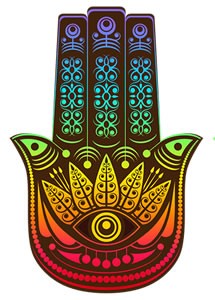
Phrases and rituals are not the only way to protect against the power of the evil eye. The most popular method of escaping the evil eye’s effects in many cultures is by the use of evil eye talismans, evil eye symbols, and evil eye jewelry. These are meant to “reflect” the power of the evil look. The evil eye amulet originated in Greece, where it was known as an “apotropaic” amulet, meaning that it reflected harm. The most basic design of the evil eye, prevalent in the Middle East, is a talisman designed with concentric blue and white circles made to symbolize the evil eye, known as the nazar. It is often used on houses, vehicles, or jewelry.
 One of the most powerful examples of the evil eye amulet in the Middle East and Africa is the Hamsa, also known as the “Hand of Fatima.” The hamsa is a hand-shaped symbol with the evil eye on the palm. The hamsa can be used in wallpaper or jewelry to ward off the evil eye. The hamsa is also found in Jewish culture, where it is known as the “Hand of God" or the "Hand of Miriam.” The popularity of Kabbalah has revived the hamsa and influenced its presence in jewelry and design.
One of the most powerful examples of the evil eye amulet in the Middle East and Africa is the Hamsa, also known as the “Hand of Fatima.” The hamsa is a hand-shaped symbol with the evil eye on the palm. The hamsa can be used in wallpaper or jewelry to ward off the evil eye. The hamsa is also found in Jewish culture, where it is known as the “Hand of God" or the "Hand of Miriam.” The popularity of Kabbalah has revived the hamsa and influenced its presence in jewelry and design.
The Evil Eye in Modern Life
The evil eye still has powerful influence in modern life, pop culture, and even jewelry and design. Who is not familiar with the phrase “the evil eye,” or thought to have caught someone casting it their way at least once or twice before? In Turkey, the Evil Eye is ingrained in every day life and has deep symbolism throughout the culture. The Evil Eye pendant is affixed to anything that is perceived to attract greed, envy, or ill-will. In Turkey, you will find the Evil Eye symbol on currency, in homes and offices, hanging from the necks of newborn children and farm animals, and in the foundations of buildings.
Evil Eye Jewelry
 The evil eye is an extremely popular piece in jewelry design at the moment. In recent years many celebrities, ranging from Madonna, Britney Spears, The Olsen Twins, Mick Jagger, and Nicole Richie (just to name a few) have been photographed wearing red Kabbalah bracelets, which are thought to be another method of protection against the evil eye. The evil eye amulet has been worn in public by celebrities such as as Cameron Diaz, Kelly Ripa, Brad Pitt, Kim Kardashian, Lindsay Lohan, Lauren Conrad, and Rhianna. Clearly, this iconic and stylish image has only increased in popularity.
The evil eye is an extremely popular piece in jewelry design at the moment. In recent years many celebrities, ranging from Madonna, Britney Spears, The Olsen Twins, Mick Jagger, and Nicole Richie (just to name a few) have been photographed wearing red Kabbalah bracelets, which are thought to be another method of protection against the evil eye. The evil eye amulet has been worn in public by celebrities such as as Cameron Diaz, Kelly Ripa, Brad Pitt, Kim Kardashian, Lindsay Lohan, Lauren Conrad, and Rhianna. Clearly, this iconic and stylish image has only increased in popularity.
The Evil Eye - Just a Myth?
Interestingly, the myth of the evil eye seems to make a lot of sense in our current world. The idea that too much fame, fortune, success, or praise can bring about one’s downfall makes, especially in celebrity culture, might reinforce the notion of the evil eye. The above mentioned Ms. Lohan, and more recently Charlie Sheen, are both examples of how the power of success can turn into disaster. Could it be that if Lindsay had been wearing the evil eye sooner, she’d be in better shape? Millions of believers would probably tell you just that. Whatever the case, those most often in the spotlight, such as celebrities, or those with success or reasons to be proud, should probably carry with them the protection of an evil eye amulet or evil eye talisman -- just to be safe!
Jewish Gift Place is proud to carry a beautiful evil eye jewelry collection.
If you enjoyed this article about the symbolism of the Evil Eye, you may also be interested in:

